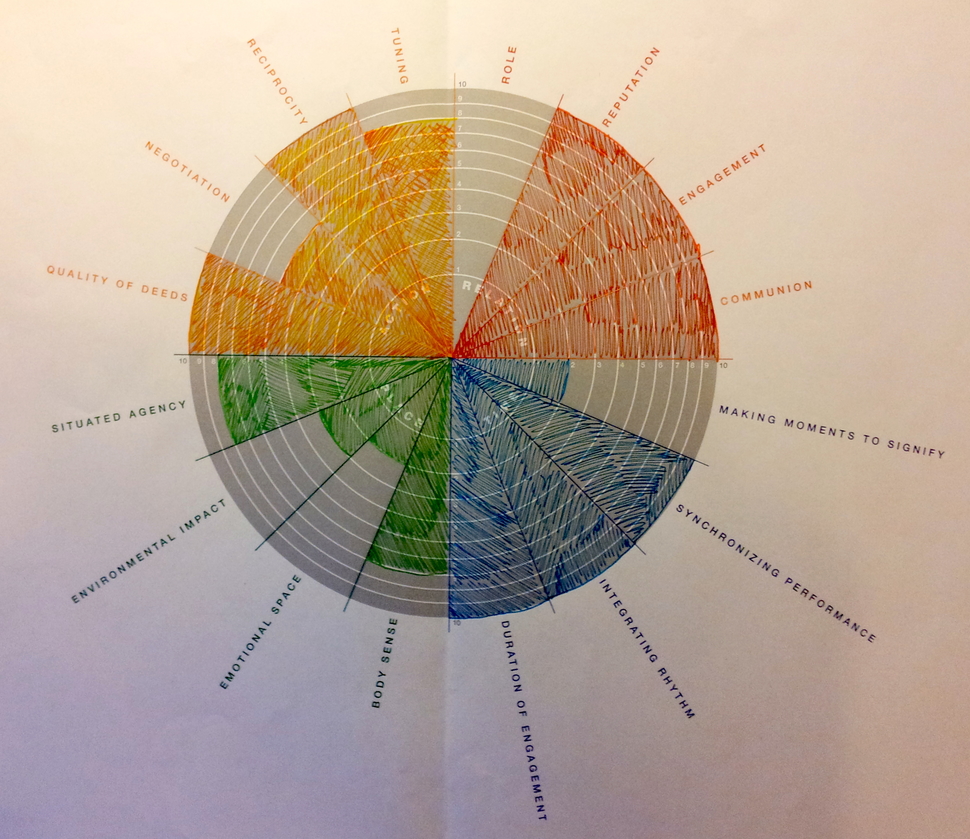The figure above shows a YUTPA-analysis for the new sustainable mobility system on Texel. YUTPA is an actronym for “to be with You in Unity of Time, Place and Action”. This analysis can be done to investigate where trust is in the different dimensions time, place, action and relation. According to Nevejan and Brazier (2014), there is a relationship between designing for presence and designing for trust. Presence is to “steer towards survival and well-being”. Nevejan and Brazier also say that “Presence as a value for design, as a requirement, facilitates designs that make it possible for us to be able to have agency, accept responsibility, and be able to engage with others in meaningful interaction, making it possible for us to steer towards our own well-being and survival.” (Nevejan & Brazier, 2014)
In our analysis, we placed the Texelaar in the middle of the circle, since we would like to focus on making the local inhabitants happy about their island. If they're happy and proud, tourists will be too. We did this YUTPA-analysis to investigate how we want the new sustainable mobility system on Texel to be perceived. This analysis shows how presence is apparent in our future system.
Looking at the first quadrant, Relation, we want the new system to have a very high engagement and sense of communion. We want Texelaars to feel that they are working together for a better future, and that being engaged pays off. We also want the reputation of the system to be good and extend outside the island. As is seen in the figure, role should not matter in our system. All Texelaars should have the same opportunity for sustainable mobility.
The second quadrant, Action, shows that we value reciprocity and quality of deeds in our new system. Tuning is also important. We want there to be room for negotiation in the system, however negotiation on all things will lead to an inefficient system, which is not attractive. We want the Texelaar to feel that if he/she contributes, he/she will get something in return.
The third quadrant, Place, shows that we would like situated agency and body sense to have a high impact. Environmental impact can be interpreted in two ways here. It can be interpreted in a way where low impact is equivalent to a sustainable system since it does not impact the environment in a negative way. It can also be interpreted in a way where a high impact is good, because it changes the environment from bad to good. We chose to interpret it in the first way, meaning that our impact is low. Emotional space is also low since we want the system to change into a direction that is new and maybe unfamiliar to the Texelaar.
The fourth and last quadrant, Time, shows that duration of engagement, integrating rhythm and synchronizing performance is very important for our system. We want to design a system where we consider the rhythm of the Texelaar and where connected actions are synchronized. We also want the duration of engagement to be long, a mobility system needs to be a long-term commitment for change to occur. Making moments signify is low, since this mobility system is not meant to be an amusement park of some sort, it is supposed to be integrated in the Texelaar’s life in a very natural way. If a tourist had been placed in the middle of the analysis, making moment signify could have been very high, since a tourist is just on the island for a short time.
Summarizing our findings, it becomes apparent that our system needs to be rooted in the community on Texel, integrated in the rhythm of the island. An interesting case to consider when planning for sustainability is Vauban. Vauban is situated 3 km outside of Freiburg in Germany. Vauban used to be a French military sight but the city of Freiburg bought it in the early 1990’s to plan a new town. Vauban is built as a sustainable town where houses are energy efficient and few people own cars. The network structure of the city promotes slow modes (walking and cycling) and makes it difficult, sometimes impossible, for cars to enter. The interesting thing about Vauban is that it was intended to be planned in a co-operative and participatory manner. An organization called “Forum Vauban” consisting of citizens had a great role in the planning process. The planning techniques used were a type of “bottom-up planning” where inhabitants are allowed to have a say in the early stages of planning. Also “learning while planning” was a technique used to be able to react to new inventions (City of Freiburg).
This is of course more difficult to make happen on an island that already has infrastructure, but the way inhabitants are allowed to be a part of planning and the way they are trusted is a great inspiration for Texel.
References
City of Freiburg. An introduction to Vauban district. Collected from Vauban: http://www.vauban.de/en/topics/history/276-an-introduction-to-vauban-district the 13th of November 2014
Nevejan, C., & Brazier, F. (2014). Design for the value of Presence. Delft University of Technology, Systems engineering.
